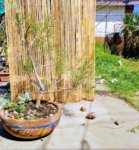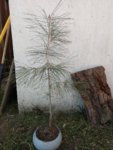headive24
Yamadori
So this is one of the first yamadori i have ever collected. I wasn't planning on collecting one of these Foothill/ghost/grey/digger/etc Pines; but this one caught my eye for whatever reason. It has still never been wired or anything; because it was only collected about 5 months ago. I am seeing new budding and the tree, in my opinion, is going to survive the initial transplant. I am looking for a pot for it and plan to probably cut off the highest branch. I've read people say not to use this species becuase of the foliage on them, but i was wondering if you guys saw any of the beauty i see in it; or if you agree it shouldn't be used. (I'm going to keep it either way). and also if anyone has a styling suggestion or potting stye suggestion. Thanks


